
Linguistic Landscapes in Europe - Alternative city tours?
The materialization of Linguistic Landscapes Studies over the past decade has made a new and challenging way of exploring the world possible. Thus, places already familiar to us can be seen in a different light. Being careful with details means that you can see the whole picture and realize how every community is interconnected with each other. This brings us to the concept of multiculturalism, which denotes the coexistence of different ethnic groups within a society.
Taking advantage of the fact that we are studying in three different countries, in this article, we will analyze and compare several multicultural shops from the Netherlands, Romania, and Belgium. The goal of the article is to highlight both the similarities and the differences between how different ethnic groups express themselves depending on the social, political, historical, and cultural context.
In order to understand the particularities and the social functions of the signs, we will examine the photos taken from the shops by analyzing the linguistic landscapes through three perspectives or arrows: backward (past), forward (future), and sideways (present).
Ethnic shops in Bucharest
In Romania, ethnic shops are harder to find, therefore we went to search for one in a particular area of Bucharest called ‘Dragonul Rosu’ (in English, Red Dragon) which is known to be a culturally diverse place. We have managed to find an Asian shop, called ‘Oriental Market’ (Figure 1).
The name of the shop is written using a big white font that contrasts with the grey background, on a huge banner above the entrance, in two different languages: English and Chinese. Therefore, the sign points toward the present, explaining the specific emplacement of the shop: in a shopping area frequented by Asians who can read Chinese, by expats who can read English, but also by Romanians for whom ‘Oriental’ has the same meaning in Romanian as in English. Moreover, this means that the sign also points to the future, to the intended audience of the shop: customers from different cultural backgrounds who want to buy oriental products. The Romanian culture is welcomed in the Asian one, but also everyone who speaks English is included, thus, English becomes the lingua franca.
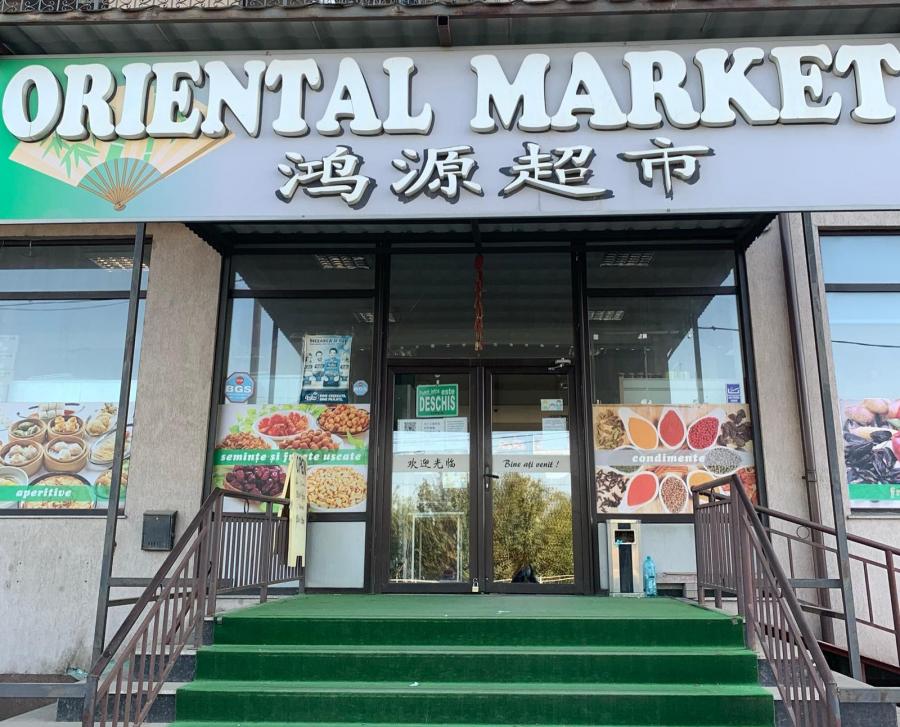
Figure 1, Oriental Market, Bucharest
The symbol of the fan accentuates the idea that the shop sells Oriental products but it also reveals its indexicality through the historical context. In the past, the fans were only used by aristocrats, therefore, by using this symbol, the shop wants to reveal the quality and superiority of their products.
After using Google Translate, we found out that the translation of the Chinese script 鸿源超市 means “Hongyuan Supermarket”, so we asked the cashier about the Chinese name of the shop. She told us that the owners of the shop are from Hongyuan County in China and so they wanted to honor their origins through the sign. Hongyuan is mentioned only in Chinese because the place has no special significance for Romanians or other ethnic groups. Thus, the sign points towards the past, showing its origins and mode of production.
Looking around the store, we have come across some jars filled with goji, which is used in China and Tibet as a culinary ingredient but also has a medical purpose. Here, the tag on the jars is written in Chinese, while the tag describing the product on the shelf is written in English. Moreover, the currency used is Romania’s LEI. (Figure 2) Therefore, there is a mix of cultures revealed through small details.
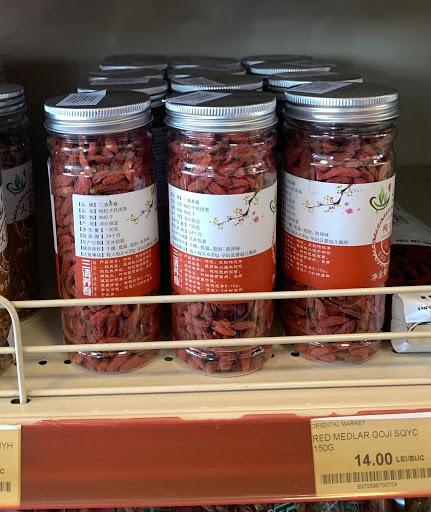
Figure 2, goji jars
After a shopping session, we went to pay for the products when we saw near the cash desk a cat figurine. (Figure 3). We noticed that it was not for sale, therefore we wanted to find out more about the reason why it was there. We interviewed the cashier to analyze the indexicality of the sign, so we wanted to find out more about the meaning of the figurine and why the owners decided to put it there. We found out the figurine is called Maneki-Neko, a symbol that brings luck to the owners.
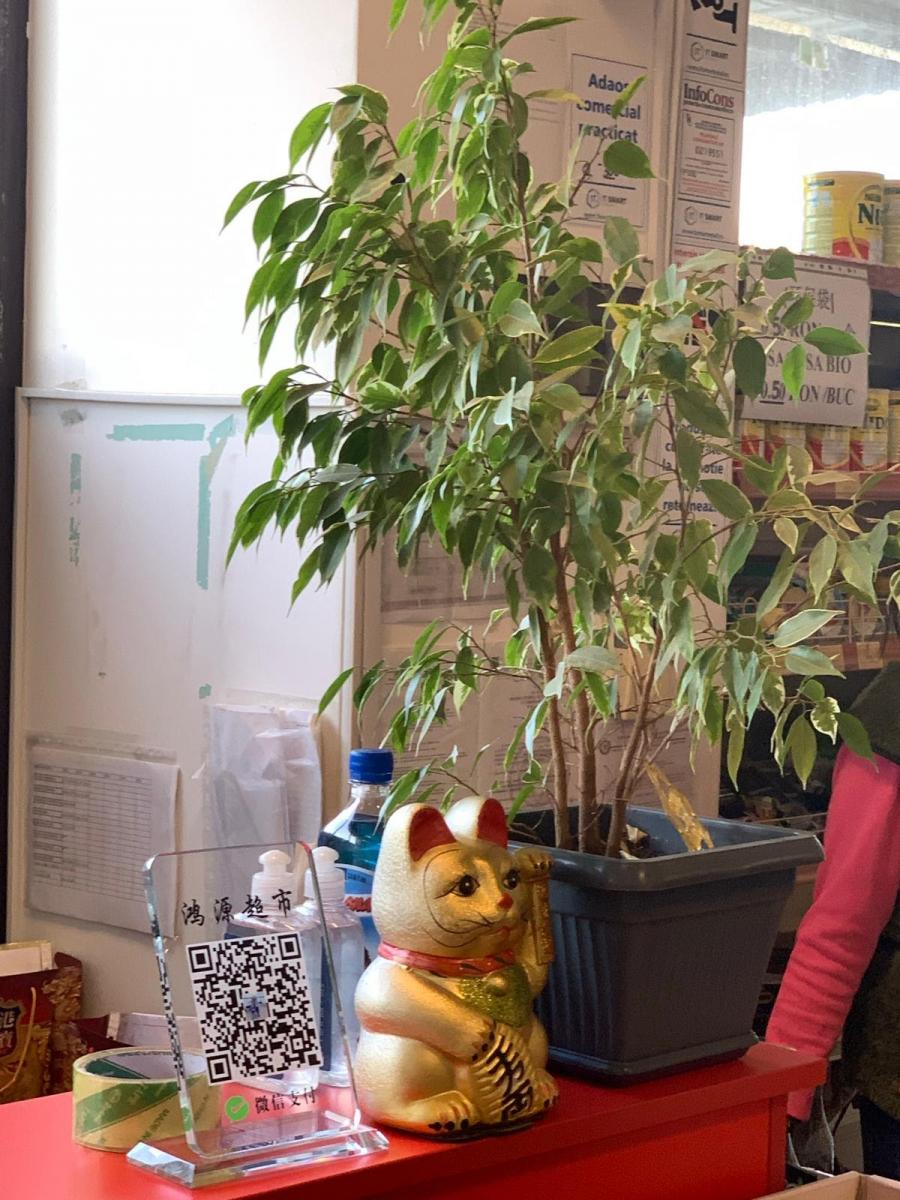
Figure 3, Maneki-neko cat
Near the Maneki-Neko cat, we noticed a QR code that we scanned. We discovered a link to the website of the shop, which confirmed once again that every sign has its indexicality, showing its origins and its addressees. The website appeared to be a complex one, with menus not only in Chinese, Romanian, and English but also in Bulgarian, French, German, Hungarian, Italian, Russian, and Turkish, which highlights the idea that the online audience is much broader and much more diverse than the offline one. Moreover, the online shop covers the entire range of products that can be found in the physical store, also delivering throughout Romania. All these strategic details point to the future and emphasize the idea that online culture manages to connect ethnic groups.
Hungry in The Hague?
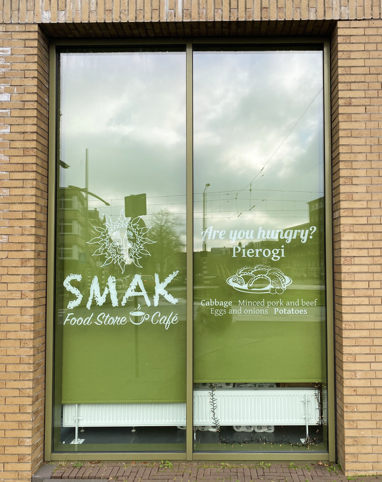
Figure 4, SMAK Food store and Cafe, The Hague
Figure 4 shows a sign of the food store and cafe SMAK in The Hague, which specializes in products and cuisine of Eastern Europe, mainly Russia and Ukraine. On the official Facebook page, the co-founders explain their aims, emphasizing the aspect of globalization and how this phenomenon helps them introduce national products across Eastern Europe to the Netherlands. Previously, the shop was located in the area of the Peace Palace and foreign embassies, aiming only at the Russian-speaking population. It is now located in the city center, within walking distance from the Central Station, which makes it accessible for a lot of people, including locals.
The sign itself is complex; it consists not only of text but also of images, which plays a huge role in understanding the context. First of all, the picture of the sun is very symbolic and refers to the folk Slavic tradition of depicting it. It could mean that the owners of the food store tried to demonstrate the similarity of cuisine and traditions of people from Russia, Ukraine, Belarus, and others. It is a connecting factor from the past and it indicates, on the one hand, the diversity of these people, but on the other, their common roots and cultural connection.
The name of the grocery store speaks for itself. ‘Smak’, from the Ukrainian language, means taste. However, it is not only a Ukrainian word. In Polish, Norwegian, and Swedish ‘smak’ has the same definition. But more importantly for our research, in Dutch, there is the word ‘smakelijk’, which means tasty. It looks like it has the same root as the word ‘smak’ and, therefore, it makes it appealing to Dutch citizens as well. From our point of view, it shows the future of the place, as it is developing and remaking for a broader audience.
Last but not least, we see the catching phrase “Are you hungry?” in English, while the reply is the Russian word “pierogi”, meaning a local dish. This fact reveals the intention of the shop owners to demonstrate that the national food of some regions can be found all over the world. It is a clear example of the phenomenon of glocalization. Still, we do not see any Cyrillic scripts, unlike the previous example of the Asian shop in Romania. We suppose that it is an indicator of internationality - the owners want to make an impression of a modern company that engages with different publics.
Multilingual signs in Leuven
The final shop we decided to examine is an Asian supermarket called ‘Asia & More 華潤超市,’ which is located in Leuven, a city in Belgium. Leuven is where the largest university in Belgium is located and with a population of close to 58.000 students, of which a little less than 10.000 students came in from abroad in 2019/20 and even more in the following academic year, you can say that the city is getting increasingly international (KU Leuven, 2019). On top of that, Leuven’s current population of people with Asian nationalities is nearly 6000, which does not include those who are ethnically Asian but have different nationalities (Leuven, n.d.). As shown below, the use of multilingual signs, therefore, indicates that they can be perceived by different audiences.
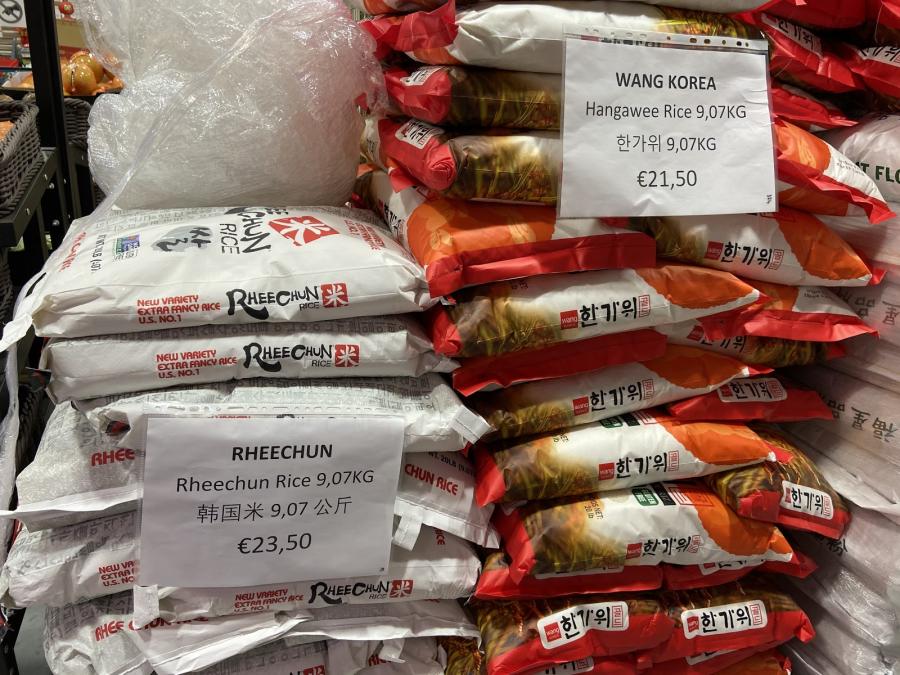
Figure 5, bilingual price signs
Upon searching for distinctive signs, we noticed papers utilized as price signs for the rice bags (Figure 5). We can see that the signs of the products are written both in English and in their languages of origin, namely Chinese and Korean respectively. Here, the use of English as a lingua franca connects both native English speakers as well as those who speak it as a foreign language. This helps customers who cannot read Dutch to understand the referential meaning. The store’s use of languages from where the products originate is used for effective communication with speakers of those languages. This is effective because they often make up most of their customers.
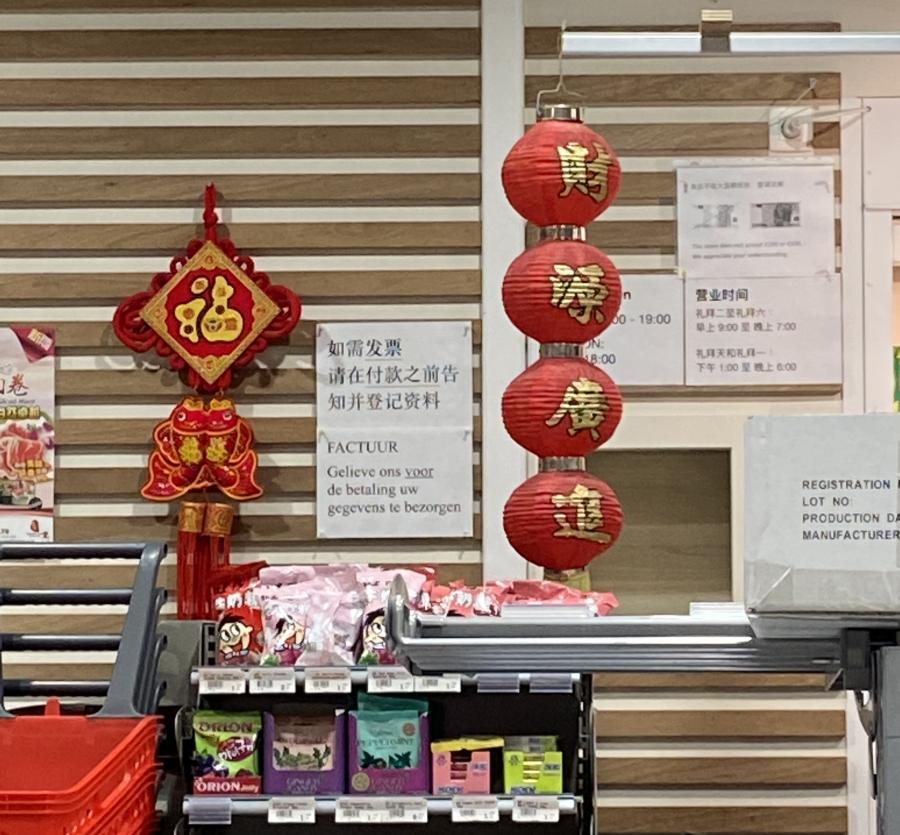
Figure 6, Chinese decorations
An assortment of Chinese decorations, such as paper lanterns and ornaments, can be seen behind the cash register (Figure 6). In China, these decorations are typically used during the Chinese New Year. To mark the end of Chinese New Year celebrations, various types of lanterns are used during the holiday of the Lantern Festival (Meredith, 2022). Red ones specifically symbolize a prosperous business and a thriving life. Outside of China, these lanterns have become synonymous with Chinese businesses, and many owners keep them hanging all year long. Besides the significance of these decorations, they can be seen as a way to make the store appear authentic to customers.
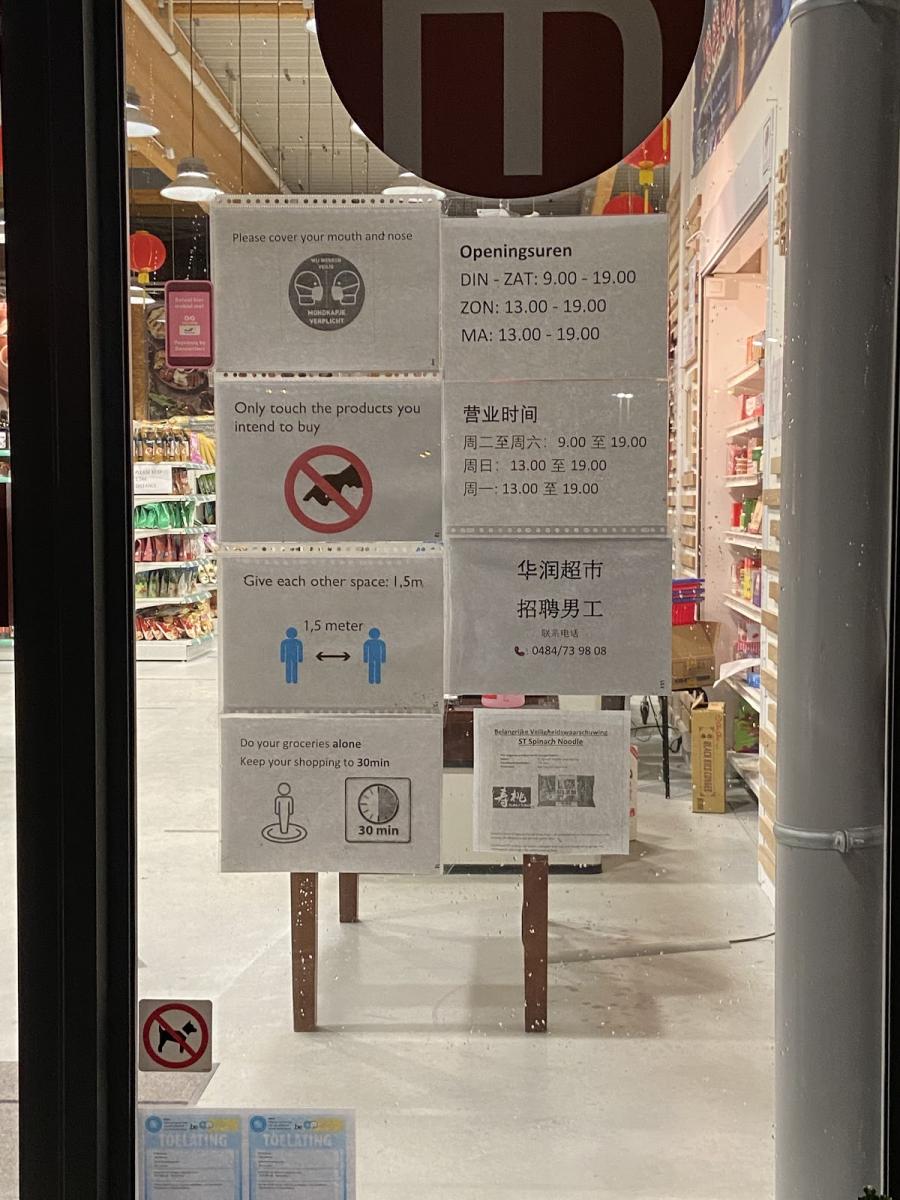
Figure 7, shop window with multilingual signs
The shop’s window displayed quite a few paper signs as well. As seen in Figure 7, the signs are mainly written in English which, again, signifies its role as a lingua franca. For the opening hours of the store, the sign is written in English and Chinese. Underneath the opening hours, there is a sign stating that they are hiring male workers. Interestingly enough, they only advertised the job offer in Chinese, therefore, from a “future arrow” perspective, we can establish that the sign constructs the identity of potential employees, namely those who are of Chinese descent or who can at least speak the language. One of the workers explained that this is because they need to be able to communicate well with their employees, and they need them to have some background information about the products they are selling to be able to introduce them to the customers or explain how to use certain ingredients.
Cultural diversity in Europe
In conclusion, the three shops analyzed above become a symbol of a superdiverse and globalized world, by revealing the effects of globalization in different sociopolitical, historical, and culturally configured countries. The similarities of the linguistic landscape such as multilingualism, English as a lingua franca, the multimodal signs and their placement, or the ways in which the shops attract customers emphasize the resemblance of the cultural manifestation of different ethnic groups. The differences between the linguistic landscape like the presence of Chinese characters and the absence of Cyrillic characters unfold the dynamism of the society, the effects of the changes remaining however unpredictable.
Furthermore, the differences between how distinct ethnic groups express themselves in Romania, the Netherlands, and Belgium reveal different levels of cultural diversity in these three countries that we live in. Immigration to Romania is less common than immigration to the Netherlands and Belgium, and that is why the number of ethnic shops, as well as their diversity, is much smaller in this country.
This way, linguistic landscape analysis allows us not only to diagnose the language situation of specific public spaces but also to ethnographically monitor and understand different social actions and changes. Therefore, visiting cities like Bucharest, The Hague, or Leuven and including ethnic shops like ‘Oriental Market’, ‘Smak’ and ‘Asia & More’ in alternative city tours could become a strategy to better understand globalization, seen as an interrelation between large different parts of the globe within systems of political, economic, cultural flows and networks.
References
Blommaert, J. (2012). Ethnography, Superdiversity and Linguistic Landscapes. Tilburg Papers in Culture Studies nr. 29.
Blommaert, J., & Maly, I. (2016). Ethnographic Linguistic Landscape Analysis and Social Change: A case study. In K. Arnaut, J. Blommaert, B. Rampton, & M. Spotti (Eds.), Language and Superdiversity (pp. 191-211). Routledge.
Leuven. (n.d.) Stad Leuven in cijfers.
Meredith, A. (2022). China’s Lantern Festival: What it is and how it’s celebrated. StudyCli.
Registration closed: KU Leuven welcomes almost 58,000 students. (2019). KU Leuven.